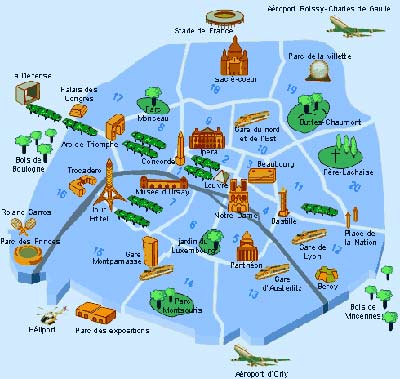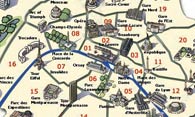Paris (Fr. Paris) 
Area: 87 km².
Grand Paris: 105.4 km².
Population: 2.15 million people.
Population density: 20,433 persons per m².
Highest point: Montmartre (130 m).
The lowest point: Bank of the Seine near Grenelle (26 m).
Physical and geographic characteristics.
The city is located in the heart of the Paris Basin, approximately 65 m above sea level. Boundaries delineated in Paris boulevard Periferik - Ring Highway. Sometimes referred to the Paris area located west of the Bois de Boulogne, and located on the east of the Bois de Vincennes. The area of the city is 105 km ², if you include the area of these parks, and about 87 km ² without them.
Seine flows through the city from east to west, on the right is dominated by the northern shore of the Montmartre hill. On the left bank is the dominant vertical tower of Montparnasse. At the heart of Paris, the river splits into the sleeves, washing the two islands - Cité and Ile Saint-Louis. Another island, Swan, located in the western part of town. The Paris Meridian, which was defined in 1718 by Jacques Cassini and more accurately measured in 1806 by French physicist Arago, was until 1884 the zero meridian on the French charts.
Climatic conditions
Paris is located in the temperate zone. The average annual temperature is 10,9° C, the average annual rainfall - 585 mm. The microclimate of Paris is less lordship during the day and lighter at night.
The hottest month is July with an average temperature of 20,0° C, the coldest - January with the temperature at +3,0° C.
Vegetable World
The forests that once covered almost the entire country, and now occupy only a quarter of the area. The largest forest tracts of natural forests are preserved in the mountains - the Vosges, Jura, Northern Alps.
The indigenous forests of France consist mainly of deciduous trees, among which the largest area is occupied by oak and beech. Of the most common softwood pine. For the northern half of the country's typical oak and beech forests with a considerable admixture of hornbeam, birch and alder in the northeast and the rule of hygrophilous beech in north-west. Consists of a dense undergrowth of heather, gorse and other shrubs with a touch of ivy, holly. For the central part of the Paris basin is characterized by open plains occupied by fields and meadows. In the north-west of France in the Massif Central, where the surface of the water resistant crystalline rocks out, meets a lot of wetlands and peat bogs, and heath, covered with heather. Towards the south there are southern species of oak in the south-western slopes of the Massif Central and Corsica grow chestnut forests. Altitudinal belts of vegetation are most pronounced in the Alps and Pyrenees. The lower slopes (up to 800 m) occupied by oak and chestnut forests with dense shrub understory. Above, in the more humid zone stretching band of beech or mixed, sometimes conifers - fir, spruce, larch, pine - forests with an undergrowth of ferns and juniper. At an altitude of 1 800-2 300 m forests give way to subalpine vegetation - thickets of dwarf pine, small brightly flowering shrubs rhododendron, tall lush meadows. Even higher alpine zone begins with a low-grass meadows of talus, rocks and snow. For the wild flora typical of the Mediterranean maquis - low, up to 3 meters thick, impassable thickets of evergreen sclerophyllous shrubs, perennial xerophytic grasses and stunted trees: holm oak, juniper, myrtle, oleander. For the Mediterranean coast are also characterized by cultural vegetation: olive groves, vineyards, a variety of southern fruit and ornamental trees along the roads and streets of the city of palm trees and agaves.
Population
In the XIII century in Paris, home to 120,000 people, with Henry II the population was about 210,000 people., Under Louis XIV - 492,600 people. In the period between 1856 and 1861. attached to the Paris suburbs surrounding area, causing the population of the capital has increased almost immediately to half a million people.
Religion
80% of the baptized, ¾ of which identify themselves as Catholics, most of them - the Latin-rite Catholics, some - the adherents of the Armenian and Byzantine rite. Total in Paris, there are 94 Catholic communities, in addition, 15 Orthodox churches, synagogues, 7 to 220,000 Jews, two of the mosque for 50,000 Muslims, mostly Sunnis.
Tourist districts in Paris
The historic center of Paris, consisting of three parts - Ville, Isle de la Cité and the University - there are more than two millennia. The longest street in Paris is the Rue de Vaugirard (4460m).
Things to Do in Paris
In Paris, there is a huge number of attractions, which include not only the architectural structures, but also the streets, bridges and squares.
French capital has is about: one hundred and sixty museums and art galleries of two hundred, a hundred theaters, more than six hundred fifty movie theaters and more than ten thousand restaurants. Its beauty, exquisite style and luxury in Paris inspired and inspiring artists and thinkers. For this he is sometimes called the "City of Light».
The historical monuments of the axis crosses the city from the center to the west. Starting from the world famous Louvre museum, it continues through the Tuileries Gardens, the Champs Elysees Avenue up to the Arc de Triomphe in the center of the square Stars. In the 1960's. line was extended even further through the business district La Defense, which has become the center of Grande Arche, as if parodying his older sister. Mod Défense, built up high business buildings of glass and concrete, in stark contrast to Paris, located next to old.
The three most famous Parisian landmarks - an ancient Notre Dame, built on the island of Cité in the XII century, the Eiffel Tower and Arc de Triomphe - the construction of the XIX century. Openwork metal tower, designed by the engineer Eiffel, was conceived as a temporary building that serves as the entrance to the World's Fair in 1889. But she not only survived the event itself, but has since become a true symbol of the city. In the north and south of it rise above the horizon Sacré-Coeur, built on top of the hill of Montmartre, and the lone Tour Montparnasse Tower, which stands out in particular its "flat" area.
The historical monuments of the axis crosses the city from the center to the west. Starting from the world famous Louvre museum, it continues through the Tuileries Gardens, the Champs Elysees Avenue up to the Arc de Triomphe in the center of the square Stars.
At the heart of historic house is disabled, which is a military museum, and here lie the remains of Napoleon Bonaparte. Immediately and the former church of the Pantheon, the guardian of the eternal peace of the once famous French figures. The former Royal Palace Conciergerie was at the time of the French Revolution, a prison for the deposed queen, where she was later escorted to a public execution.
Another reminder of the blazing battles for the freedom of the French people - Statue of Liberty, set on Swan Island.
In the historic city center, on the island of Cité are the two most famous churches of France: Notre Dame and Holy Chapel.
Public transport
In Paris, you can use different modes of transport, but the most popular here - the tram and bicycle. Recently in Paris, built a new special parking for cyclists - Velib '. Then leave under the supervision of their bikes are not only local but also tourists.
Tram in Paris itself is rarely seen, because the city is laid only a great line, but outside the city of three, they take to the ring suburbs of Paris, and they are easy to reach from one end of town to another.
PARIS - The city of lovers, of course, the most fascinating of the European capitals, which want to visit everything. And it is not surprising if we recall his dignity - beautiful architecture, high fashion, fine cuisine, the center of political, economic, historical, and cultural life.
ECONOMY
■ The services sector (73% of all jobs), financial institutions, typography, press, publishing houses, wholesale and retail trade.
■ The largest river port in France.
■ Tourism (Paris ranked by the number of tourists annually visit the city of 20 million people).
■ Greater Paris (the city itself and its many suburbs): a quarter of total industrial production in France, one third of total national services.
The history of Paris
The story began in Paris on a small island, washed by the waters of the Seine, where in the III century BC the first "Parisians." It was the Celts who founded a settlement here Lu tribe Parisien on the site of the present Ile de la Cité. The first written mention of Lutetia is found in the second book of Julius Caesar on the war in Gaul in 53 BC.
When in 52 BC. Oe. the Romans after the first unsuccessful attempt for the second time tried to come to town, set fire to Lutetia Parisi and destroyed bridges. The Romans left their island and built on the left bank of the Seine, a new city. There they built baths, a forum and amphitheater. In the Roman Empire, the city has not had much impact.
Board of the Romans ended in 508, when Paris became the capital of the Merovingian dynasty of Franks under the rule of Clovis I. During the reign of the Carolingian, the town was attacked by the Normans. Capet made Paris the capital of France. When Philip II Augustus was strengthened defense of the city: in 1190 a wall was built on the right bank of the Seine, and in 1210 - on the left bank. By order of Philip on the western outskirts of Paris, the Louvre was erected.
In 1181 opened the first indoor market, and in 1301 on the Ile de la Cité was built by the royal palace. During the Hundred Years' War, Paris was occupied from 1420 to 1436 by the British.
By order of Louis XIV was established street lighting, upgraded water system and built hospitals, and Les Invalides Salpetri. The city walls were demolished, and built in their place "Grands Boulevards". The residence of King moved to Versailles, but Paris still remained the political center of the country, thanks to the growing population, and the leading role of Paris in the economy.
Paris karte.
The streets of Paris are narrow. There are many traffic jams on most of the roads, so the workers generally go to work by subway. There are few parking spaces in the city center.
In Paris you can go by subway, suburban train and bus. The French call the subway "Metro".
When I was in Paris, I took a tour of the city by private car as well as by suburban train and subway. The buildings in Paris are older than in Germany is not so high. Through the city "Paris" flows a river, which is called "Seine". In this city live many foreigners who came mostly from African countries. We went to Paris two times grilled and visited many historic buildings. For example, a castle, a church, the Eiffel Tower.












